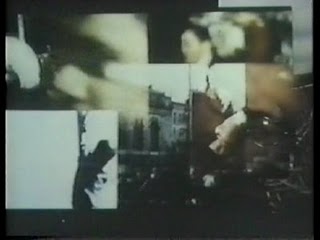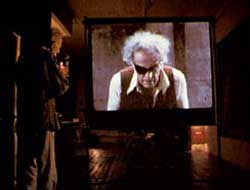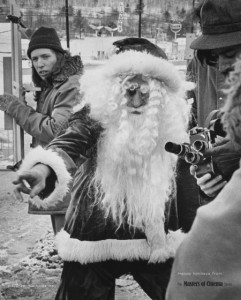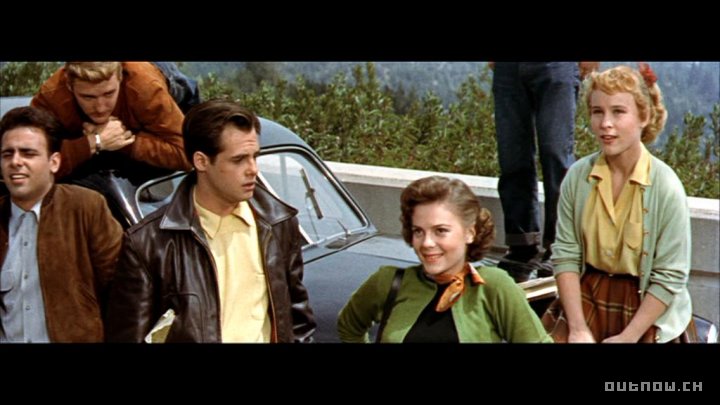Written for the Abril 2012 issue of Caimán Cuadernos de Cine. — J.R.
Nick was a gambler — a gambler who often lost.
— Susan Ray in Don’t Expect Too Much
One of the paradoxes of Nicholas Ray’s legend is that in order for it to function, he can’t be regarded simply as either a Hollywood director or as a struggling maverick, but as both. Seen exclusively as the former, he becomes the faceless but coherent and competent metteur en scene of A Woman’s Secret (1949) or Flying Leathernecks (1951). Seen exclusively as the latter, he becomes the personal but incoherent auteur of We Can’t Go Home Again (1973).
A similar problem has informed the career of Ray’s most important disciple, Jean-Luc Godard, another tormented romantic widely regarded as a leftist visionary when he made La chinoise and Week End in 1967, when his work was still sufficiently close to commercial cinema to reflect some of its slickness and glamour. But following May 1968, once he deliberately divested himself of that slickness and glamour and his films had to be judged on their political insights and their political utility alone, he was no less appropriately regarded as misguided and obtuse. Admittedly, Godard’s shift to a more collective and non-commercial profile came about much more quickly and deliberately. But the abyss separating We Can’t Go Home Again from Johnny Guitar (1954) remains in many respects comparable to the gulf between A bout de souffle (1960) and Vladimir et Rosa (1971). And between the multiple-image formats of Godard’s Numéro deux and Ray’s scattershot testament, the former can at least claim a certain theoretical coherence about reverse angles that Ray’s film lacks.
I attended the first European showings of We Can’t Go Home Again — a private gathering at the Cinémathèque Française on April 9, 1973, when an attempt to project 35 mm, 16 mm, and super-8 reels simultaneously ended in chaos; then the world premiere in its still-unfinished state on May 24, on the penultimate day of the Cannes Film Festival, when most of the international press was too exhausted to be paying much attention. A few mornings later in Paris, I ran into Ray, dressed like a Gypsy, and bought him tequilia with a beer chaser at the Café aux Deux Magots. The only other time I met him after that, in lower Manhattan in December 1977, he was off alcohol and wearing a suit. His film was seemingly no closer to being finished then, and frankly this struck me as hopeful news.
I’ve seen the film many more times since then. I met Ray’s widow Susan shortly after his death in June 1979, and saw about a third of Ray’s never-completed revised second version of the film on an editing table a year later. It seemed like a marginal improvement, but I can’t remember much more about it today. The restoration that premiered in Venice last summer and has subsequently been circling the globe is in fact an upgrading of the first version, to which Susan has added Nick’s offscreen voice (and, in the opening sequence, subtracted the introductory voiceover of Tom Farrell, one of Ray’s students and the leading actor in what follows.) She also made an informative 73-minute documentary about the project called Don’t Expect Too Much, which ends, aptly, with Victor Erice calling We Can’t Go Home Again a failed film that is exemplary in its failure.
Now it’s more a failed film about Ray than one about his students (or about “US,” as an opening title puts it). Don’t Expect Too Much is lucid about some of the reasons for this failure, including Ray’s addictions to alcohol and drugs, but We Can’t Go Home Again is more evasive. The former opens with Ray quoting and imitating a harangue of Abbie Hoffman to art students: “What is art? Fuck art! Art is what you’re doing. Art is politics. Art teaches living,” to which Ray adds, in his own voice, “Politics is living.” But this notion — which echoes the ethics and aesthetics of action painting in the 1950s, as theorized by Harold Rosenberg — prompted Mary McCarthy to object, “You can’t hang an event on a wall.” This raises the theoretical question of whether you can project an event (as opposed to the shadow of an event) on a wall, either — or, for that matter, download or watch the same event on a computer or a mobile. And tragically yet inevitably, what Ray described in Cannes as “what in our minds is a Guernica,” made out of such tools as a “broken-down Bolex,” “a Mitchell that cost $25 out of Navy surplus,” and a crew and cast of college students, never gets far enough beyond a style of living to register as either an event or a statement of any depth. Having lost its political raison d’être, it survives mainly as a historical artifact, yet even for this it needs the clarifications of Don’t Expect Too Much.
Ray stages his own death twice — first as Santa Claus hit by a car, then as himself, a suicide by hanging (which he begins abjectly and ends involuntarily, like the suicide of Godard’s Pierrot le fou). The only lesson arising from this is self-loathing and affection for his young collaborators: “Take care of each other — all the rest is vanity — and let the rest of us swing.” Bitter Victory also expressed self-hatred (along with vanity), but with a devastating critique of the macho posturings of both its heroes. Here the pain, most of it self-inflicted — Tom Farrell’s while shaving off his beard, the angry masochism of Leslie Levinson (another student), Ray’s while dying twice — is devoid of self-reflection or analysis. Once politics becomes confused with psychoanalysis, neither can function with much purpose.
In terms of his lifestyle, Ray was a pioneer — a child of 30s radicalism who was living collectively with some of his teenage cast members in Rebel Without a Cause almost two decades before We Can’t Go Home Again. More generally, the way he benefited from his utopian background in architecture, theater, folk music, and committed protest made many of the themes, subjects, and stylistic inflections of his 50s films at least a decade ahead of their times: alienated youth culture, drugs, ecology, alternative lifestyles, ethnic subcultures, ethnography, a mystic equality between couples and/or antagonists, pop Christianity, Cinemascope, choreographed violence, passionate comic-strip colors. Yet his effort to apply this vision to low-budget 70s filmmaking is advanced and expressive only in its multi-image mosaic format and its emotional impact, which resembles a scream. Otherwise, it can only replicate the breadth of its anguish and despair, not offer any strategies for transcendence.






